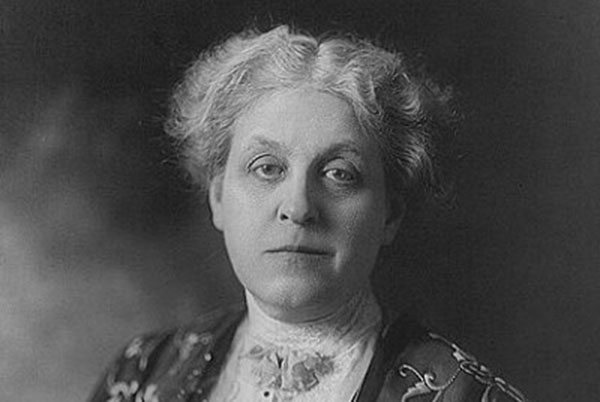Carrie Chapman Catt took leadership of the women’s suffrage movement in 1900, steering the drive to win women’s right to vote.
Carrie Chapman Catt was born in Ripon, Wisconsin in 1859, and moved to Iowa with her parents seven years later. As a first year student at Iowa Agricultural College She (which became Iowa State University) she demonstrated her gift for public speaking. She was just 18 years old when she not only argued that women had equal rights with men to an education, but went on to insist on women’s right to vote. She graduated in 1880, the only woman in her class.
Catt’s public speaking skills were put into use as she began lecturing across the state, focusing on the temperance movement and other political topics, including women’s rights. When Iowa pushed for suffrage, she joined the movement and took on responsibilities as lecturer and organizer. Catt quickly gained the attention of national women’s rights leaders, who dispatched her to other states, building support for suffrage by working with local women’s group.
Leading the National Woman Suffrage Association
Weary after a hard-fought struggle as leader of the National American Women Suffrage Association (NAWSA), Susan B. Anthony retired at age 80, turning over her leadership role to 41 year-old Carrie Chapman Catt. Anthony had been a mentor to Catt, whom she wryly referred to as her “right hand man.” Under the tutelage of Susan B. Anthony, she had recruited and trained suffragists, organized meetings and speakers across the country, and raised funds to keep the movement going.
This passing of the leadership torch became official at the National American Woman Suffrage Association convention (NAWSA) in 1900. To the cheering crowd, Anthony presented Catt as her choice to succeed her as president of the organization. By this time she had earned a well-earned reputation for hard work and deep commitment to women’s rights .
Her term was cut short four years later when she resigned to care for her ailing husband, George Catt. After his death, she again became a driving force promoting women’s rights. This time Catt traveled the world. She had helped found the International Women Suffrage Alliance (IWSSA) in 1902 and went to work as an ambassador for worldwide women’s suffrage. She met with women’s groups in the early 1910s, during extensive tours in Europe, as well as into South Africa, India and China.
Catt’s Winning Plan for Women’s Right to Vote
In 1915, Catt once again was named NAWSA president. She took over a weakened organization, one that was struggling with the chronic problems of a shrinking membership and little money. Catt wasted no time in taking action. At the 1916 NAWSA convention in Atlantic City, New Jersey, she presented her plan to win suffrage on both the state and federal levels, and to compromise for partial suffrage in the states resisting change.
Months of pressing the issue to supporters and opponents paid off. Under Catt’s leadership, NAWSA first won the backing of the House and Senate, followed by state by state campaigns for ratification of the amendment which was required in every state. Wisconsin and Illinois were within the week. Ratification by other states was completed in 1920. At last, on August 26, 1920, the Nineteenth Amendment became part of the United States Constitution, and women officially gained the right to vote.
The victory moved Catt to say: This is a glorious and wonderful day. Now that we have the vote, let us remember that we are no longer petitioners. We are not the wards of the nation but free and equal citizens. Let us do our part to keep it a true and triumphant democracy.
American Women’s Suffrage Association Becomes League of Women Voters
The League of Women Voters was founded by Carrie Chapman Catt in 1920 during the convention of the National American Woman Suffrage Association. The convention was held just six months before the 19th amendment to the U.S. Constitution was ratified, giving women the right to vote. The League’s expressed purpose was to support the 20 million women as first-time voters. In later years, the League expanded to effect change on health care, environment, campaign finance reform, education, and always, women’s rights.
The Final Years Working for World Peace
Carrie Chapman Catt didn’t rest after the passage of the 19th Amendment. Along with other women activists, she established the Pan-American Alliance for the Advancement of Women, and served a year as its president. The same year, she and Nettie Shuler co-authored “Woman and Suffrage and Politics: The Inner Story of the Suffrage Movement.” Now, though, her focus turned to world peace. She led the first meeting of the Committee on the Cause and Cure of War, and served as its president from 1925 to 1932. During World War II She threw her energies into helping Jewish people suffering under the tyranny of the Nazi regime. Once again, she wrote letters, press releases and resolutions to push for assistance for those in concentration camps and ghettos. Carrie Chapman died at age 88, on March 8, 1947 at her home in New Rochelle, New York.
Sources:
- Sherr, Lynn. Failure is Impossible. Susan B. Anthony in Her Own Words. Times Books. 1995.p.320.
- Thoennes Keller, Kristin. Carrie Chapman Catt: A Voice for Women. Compass Point Books. 2006. p.86.








